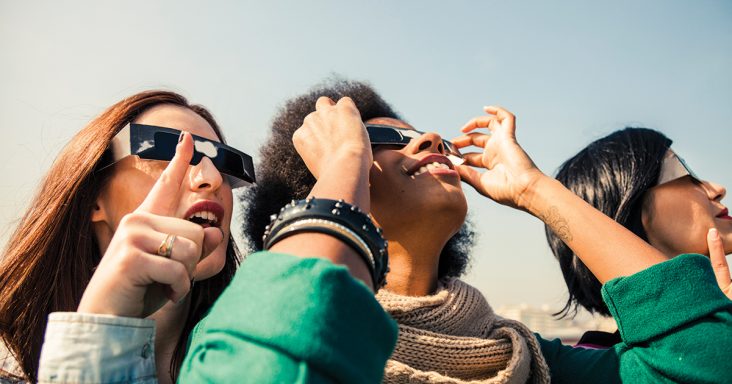Residents ready for total eclipse
by February 28, 2024 5:51 pm 1,363 views

In the middle of the Neolithic period more than 5,300 years ago, mysterious tombs and carvings were erected and etched in Loughcrew, an area in County Meade in Ireland. When archeologists studied these tombs and carvings one thing became clear — ancient Irish astronomers had an uncanny ability to predict celestial events such as when the winter and summer solstices would occur.
One event that they possibly predicted has been etched in stone forever.
A series of spiral-shaped and circular petroglyphs was found at the Loughcrew Megalithic Monument and they depict a solar eclipse that dates to Nov. 30, 3340 B.C.E. — the oldest solar eclipse ever recorded in human history, according to NASA. Near the monument the charred remains of about 50 people were found, a possible indication of a human sacrifice to mark the event.
Civilizations throughout time have been fascinated by solar eclipses and many have assigned deep spiritual and religious meanings to these events. The phenomenon is fairly common. There are up to five each year across the world, but they impact a small area, meaning it can be rare to experience one without traveling, Arkansas State University physics professor Dr. Ross Carroll told Talk Business & Politics.
On April 8, Northeast Arkansas will be ground zero for a full solar eclipse. An estimated 2 million people will drive in and around Arkansas to view the solar event. Such movement will result in an estimated 700,000 extra vehicle trips, according to a traffic management plan from the Arkansas Department of Transportation (ARDOT).
When the Moon passes between the sun and Earth that day, a 117.9-mile-wide “shadow” will move northeast from the southwest corner of Arkansas at around 1:46 p.m. and exit the state around 2 p.m. near Pocahontas. The period of darkness for any location is estimated to last around 4 minutes. Parts of Jonesboro will be in the direct path of the eclipse for up to 3 minutes, Carroll noted, but the path is so narrow that towns just east of NEA’s hub city such as Bay will only experience part of the eclipse.

“It’s just a fascinating physical phenomenon,” Carroll said. “Literally, the moon gets in the way of the sun.”
NEA towns and cities have been preparing for months to accommodate the surge of tourists. Anecdotally, many hotels have been booked and an estimated 125,000 tourists from around the state and county could stay at least one night in the region.
Gauging the economic impacts of the solar eclipse can be tricky. The last solar eclipse in the contiguous United States was Aug. 21, 2017. That eclipse tracked from Oregon to South Carolina. The American Astronomical Society reported that in South Carolina more than 1.6 million people visited the state for that event and it had a $269 million impact to the state’s economy.
There will be problems associated with the expected number of tourists.
ARDOT predicts that 1.5 million people will travel from outside the state, along with 500,000 Arkansans who will travel from their residences to visit the viewing area. This will result in the influx of approximately 700,000 extra vehicle trips into the path of totality. ARDOT will coordinate with other agencies and officials at the state, county, and local levels before, during, and after the eclipse to ensure consistent messaging and communication is provided to citizens and visitors.
Data from the 2017 eclipses showed that approximately 30% of the sightseers arrived on the day of the event, and up to 80% left immediately after sunlight returned. That pattern is expected for the 2024 eclipse, ARDOT reported.
The solar eclipse won’t just provide a tourist experience, Carroll said. It will provide an opportunity to study the sun’s outer corona or atmosphere. Light from the sun makes studying the corona difficult. The corona is dim compared to the surface of the sun due to its density which makes it hard to see under normal conditions.
Scientists still don’t know exactly why, but the sun’s corona is many times hotter than its surface which seems counterintuitive, Carroll said.
Researchers from A-State, including students, will work with NASA to study the eclipse in Arkansas. The plan is to release a high-altitude balloon from Mount Petit Jean the day of the eclipse. The balloon will rise to about 100,000 feet and will carry a number of scientific tools including cameras.
Solar eclipses have a temporary, but real impact on the atmosphere in the area in which they occur. Carroll said the hope is that the instruments on the balloon will record information that will help explain better the specific impacts to the atmosphere.
Another goal is to generate student interest in NASA, space and just science in general, Carroll said. Students from around the world will be able to track the eclipse online in real time. For some it could be a unique, once in a lifetime opportunity. According to NASA, the next total solar eclipse to travel across the contiguous U.S. will be Aug. 23, 2044.
Carroll said he considers himself an “umbra file,” a person who is fascinated by the shadow produced when the sun’s light is blocked by the moon. In 2017, he traveled to Missouri to experience the last solar eclipse. As the moon begins to cover the sun, strange shadows begin to develop on the ground. As it gets darker and cooler, visual things appear much different on the ground, he said. Colors lose contrast and shadows become sharper, he added.
“It’s really an experience,” he said.
Scientists can predict solar eclipses well into the future and can pinpoint when these events happened in the past, but there is one contingency that could stymie the whole thing — the weather. Carroll said they’ve researched data for weather patterns in Arkansas on April 8 and they found that many days it is sunny. But it is spring, and storms could be an issue, he said.
Millions will view the solar eclipse and the main precaution viewers need to take is to have proper eyewear, he said. Looking directly into a solar eclipse without proper eyewear can cause significant damage to your eyes, he said.
“Get your solar glasses from a reputable source. There are a lot of knockoffs out there,” Carroll said.
